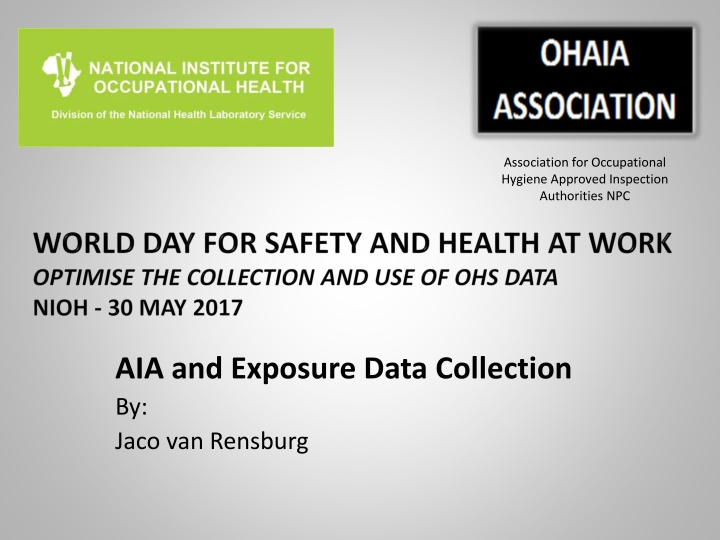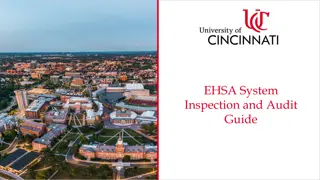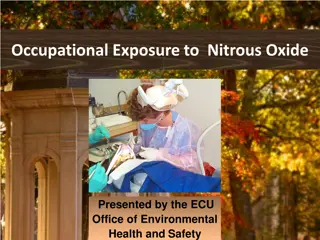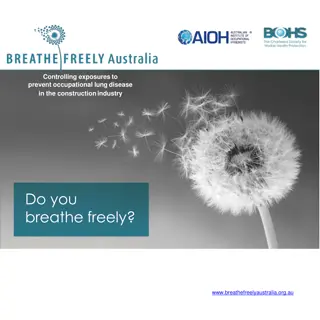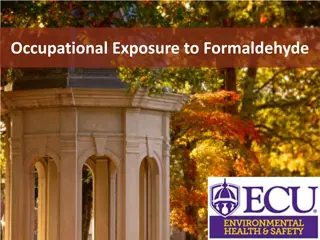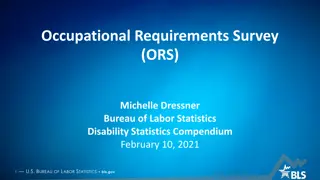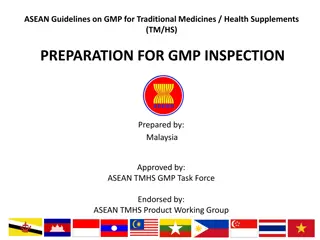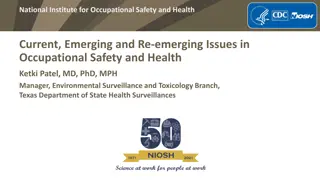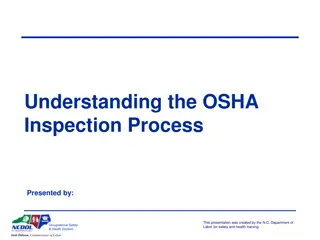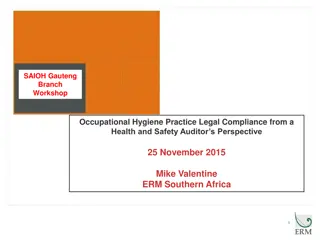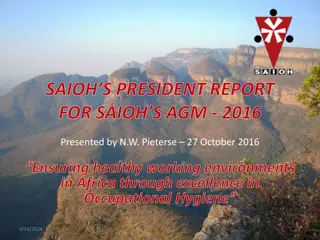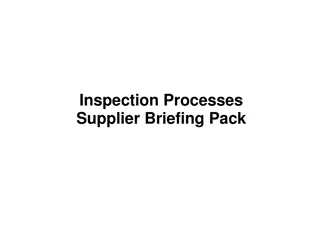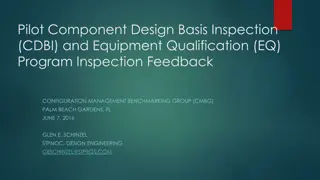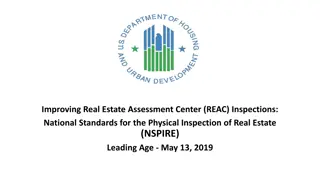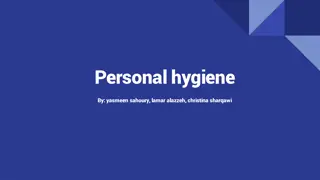Occupational Hygiene Approved Inspection Authorities and Exposure Data Collection
The Occupational Health and Safety Act defines an Approved Inspection Authority (AIA) as a person who, with specialized knowledge and equipment, provides services by making objective findings regarding exposure, safety, health risks, compliance with standards, etc. An AIA must be approved by the Chief Inspector to operate, and strict requirements apply to Occupational Hygiene Survey Reports. To become an Occupational Hygiene AIA, one needs competency in monitoring, appropriate facilities, and equipment, and must meet specific criteria for approval.
Download Presentation

Please find below an Image/Link to download the presentation.
The content on the website is provided AS IS for your information and personal use only. It may not be sold, licensed, or shared on other websites without obtaining consent from the author.If you encounter any issues during the download, it is possible that the publisher has removed the file from their server.
You are allowed to download the files provided on this website for personal or commercial use, subject to the condition that they are used lawfully. All files are the property of their respective owners.
The content on the website is provided AS IS for your information and personal use only. It may not be sold, licensed, or shared on other websites without obtaining consent from the author.
E N D
Presentation Transcript
Association for Occupational Hygiene Approved Inspection Authorities NPC AIA and Exposure Data Collection By: Jaco van Rensburg
Or more specific, what is an Occupational Hygiene (OH) AIA? The Occupational Health and Safety Act, 1993 (Act No. 85 of 1993), defines an Approved Inspection Authority as: any person who with the aid of specialised knowledge or equipment or after such investigations, tests, sampling or analyses as he may consider necessary, and whether for reward or otherwise, renders a service by making special findings, purporting to be objective findings, as to: the exposure of any person, the safety or risk to health of any work, article, substance, plant or machinery, or any condition prevalent on or in any premises the question of whether any particular legislated standard has been or is being complied with, ., and by issuing a certificate, stating such findings, to the person to whom the service is rendered. o o o
., an Inspection Authority can only operate if it has been approved by the Chief Inspector (of the DoL). The AIA with respect to any particular service shall be an Approved Inspection Authority with respect to that service only. DoL sexplanatory notes on the above: The meaning of a certificate should also be read as a report/statement/certificate as pertaining to each specific situation . Actually, DoL has very strict requirements on the format and contents of an Occupational Hygiene Survey Report, issued by and AIA and it goes way beyond the traditional understanding of a certificate Scientific Report is probably the only and best fitting term to use in this context.
What is required to become an OH AIA? An inspection authority, which has the necessary competency in the field of occupational hygiene monitoring and has the appropriate facilities and equipment, may apply .. Very Important - The use of the term monitoring (according to DoL) means more than just measuring an occupational hygiene stress factor. It includes the collection (and thus recording) of data associated with a measurement: Identification of workplaces which could cause or exacerbate adverse health effects Measurement of prevailing conditions Scientific interpretation of those measurement results Evaluation of the potential impairment of health or well-being Formulation of recommendations for alleviation of such problems.
Any application to the Dol for approval will, in general, be evaluated in terms of the following: must hold a certificate of accreditation from the South African National Accreditation System (SANAS) i.e. SANS 17020:2012; Personnel must be currently registered with a professional occupational hygiene organisation recognised by the Chief Inspector (e.g. SAIOH); Personnel must hold a valid legal knowledge certificates; The AIA must have the basic suitable monitoring and analytical equipment pertinent to the service/s rendered; The AIA must keep a logbook of calibration and maintenance schedules and records for all relevant equipment for a period of five years The AIA must have suitably documented, methods and procedures relating to the regulated services they wish to render. The AIA must have suitably documented record keeping and control system.
Regarding documentation (including records of Inspection/OH Survey data), DoL requires that: the OH AIA implements a quality management system in accordance with SANS 17020; A formal system is in place for indexing and retrieving all reports and other records (i.e. data); All records are kept secure and in confidence; Procedures are in place to protect and back-up any data that is held on computers. The word record (or related terms; records, recorded) appears 19 times in SANS 17020 (the contents of document itself is less than 18 pages) recording of data and keeping of records (of data) is thus extremely important to the OH AIA.
So why is DoL so obsessed with the requirement that AIAs must record data and keep records of that? (also expressed through its requirement that AIAs must be SANAS accredited) Because - being DoL Approved, these reports compiled by an OH AIA, on exposure measurements, are legal documents and can be presented as evidence in a court of law.
And, any evidence presented in a court of law, must be able to withstand the acid test , meaning, one must be able to prove that the result is a true reflection of that what it represents: one must be able to prove that the result obtained is accurate there must thus be a trail of evidence (recorded data) that can prove that the correct methodology and procedures were followed when the measurement was conducted (and that is was conducted with the aid of valid, calibrated instruments); there must be a trail of evidence (recorded data), that can recall the conditions under which the measurement was made exposure (and process) related conditions, as well as environmental conditions; sufficient evidence (recorded data) to conclude whether the measured exposure result is representative of normal exposure conditions, or whether the reported result is representative of higher or lower than normal exposure levels. This type of data is thus very valuable; hence the requirement for safe-keeping for extended periods of time.
It is further a requirement (as per SANS 17020) that all data, in its raw form as well as results from calculations, collected by one person, are checked and verified by another person (of a higher competence level). To that end, all AIAs have developed aides and tools to ensure that for each measurement, sufficient data is collected to be able to recall and re-trace (even at a much a later stage), what was measured, how it was measured, by whom, when, where, under which circumstances, using which tools and verified by whom ..the so-called field data collection sheet , as well as standardized, validated Excel spreadsheets that are used for calculations.
Exposure Data collected by an OH AIA must: be collected by a competent person (SAIOH registered professional), be traceable to the person that collected the data, be traceable to the person that reviewed the data and calculations, be traceable to a specific result in a report, accurately describe the equipment (traceable to their calibration certificates) used in the processes and procedures followed to make the exposure measurement, be able to demonstrate that the correct measurement methodology was followed correctly, be able to accurately reflect where and when the measurement was collected and for how long, be able to recall the conditions that prevailed during the measurement, be able to accurately recall the person who s exposure level was measured, include sufficient detail to demonstrate that either no systematic errors were incurred, or be able to conclude on the extent of the impact of such upset condition on the result, be stored safely, but also be easily retrievable.
Exposure data should be able to outlive the person that collected it, so, it must be accurate and detailed enough to ensure that the result that it supports will be able to withstand the acid test , even in the absence of the person that actually performed the measurement.
The motto is (or should be); It is impossible to collect too much data (when conducting an OH measurement), because as with many other things in life, it is better to have too much and not need all of it, than to need it (to withstand the acid test) and not have enough .
Association for Occupational Hygiene Approved Inspection Authorities Reg. No.:2014/212083/08 NPC Vat Registration: Not VAT Registered PO Box 7211 Centurion 0046 aiaforum1@gmail.com
